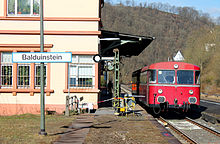Balduinstein station
| Balduinstein | |
|---|---|
|
Entrance building of the Balduinstein train station
|
|
| Data | |
| Operating point type | railway station |
| Platform tracks | 2 |
| abbreviation | FBAD |
| IBNR | 8000786 |
| Price range | 6th |
| opening | July 5, 1862 |
| Profile on Bahnhof.de | Balduinstein |
| Architectural data | |
| Architectural style | Late classicism |
| architect | Heinrich Velde |
| location | |
| City / municipality | Balduinstein |
| country | Rhineland-Palatinate |
| Country | Germany |
| Coordinates | 50 ° 20 '49 " N , 7 ° 58' 5" E |
| Railway lines | |
|
|
| Railway stations in Rhineland-Palatinate | |
Balduinstein is a train station on the Lahn Valley Railway . It is located north of the local community Balduinstein on the banks of the Lahn .
Building history

The Bonn-based construction company Spuhn , which was awarded the contract to build the Lahn Valley Railway between Balduinstein and Runkel , began work in Balduinstein in autumn 1857. Since August of that year, the Georg Mayer company from Alzey has been working on the Cramberger Tunnel , the east portal of which is south of Balduinstein. The resulting material was used to fill the railway line, which had to give way to numerous houses by the summer of 1860. A number of underpasses and crossings ensured that residents had access to the Lahn.
The late classicist station building was designed by the Diez architect Heinrich Velde , who also designed numerous other buildings along the railway line. The two-storey building was very spacious with three-storey corner buildings and an arbor-like vestibule. Archduke Stefan Franz Viktor of Austria , who had withdrawn to his adjoining county of Holzappel since 1850 , wanted a representative reception building for his guests at the newly designed Schaumburg and had presented this matter to the ruling Adolph von Nassau .
The “Prince's Room” intended for the ducal guests, which had its own entrance from the station forecourt and platform access, turned out to be too small with 15 square meters of floor space at the latest in the summer of 1863. Archduke Stefan then asked to be allowed to use "the corner room on the first floor" as a waiting room for his guests. Nowadays the “Fürstenzimmer” is used as a regular platform access for all passengers.
On September 9, 1991 the station building was included in the list of monuments of the state of Rhineland-Palatinate . The district administration of the Rhein-Lahn-Kreis announced that the Balduinstein train station was "a testament to artistic creation and technical activity [...] in the Lahn valley". In addition, the building is a “distinctive feature” of the location, and there is public interest in its preservation and maintenance for urban planning and artistic reasons.
Change of ownership
Deutsche Bahn AG sold the building in February 2004 to “First Real Estate Grundbesitz GmbH” (FRE), which went bankrupt in autumn 2007. Subsequently, a “Property First GmbH” from Dortmund, the “Main Asset Management GmbH” and the Luxembourg company “Patron Elke SarL” acted as owners. On June 20, 2015, following a bidding competition, the Karhausen AG auction house auctioned the building for the “exceptionally high” sales price of 120,000 euros to a bidder residing in Limburg. With the renovation of the Lahn Valley Railway, it will no longer have a function for Deutsche Bahn from mid-August 2015.
Reorganization
After the station has lost its original function, the main building is currently (as of August 2020) being extensively restored by the new owner. In addition to four residential parties on the two upper floors, there is the "Stellwerk coffee house" with catering on the ground floor. In 2019, the Café Gleis 3 - Lahn-Terrasse was opened in the outdoor area with small homemade dishes, Italian ice cream and drinks.
traffic
Balduinstein station was put into operation on July 5, 1862 with the opening of the Nassau - Limburg section . At the beginning, four passenger trains stopped daily in each direction. The travel time to Limburg with a stop in Fachingen was 25 minutes (2012: 11 minutes), without the stop, which was only made once a day, only 20.
literature
- Willi Bode: Construction of the Lahn Valley Railway. In: Balduinstein. (Local history book series on the eastern Rhenish Slate Mountains, Volume 4). Lahnbrück-Verlag, Weilburg 2011. ISBN 978-3-9812777-6-0 , pp. 10-121
- Arno Baumann, Bernd Geil, Hans-Jürgen Sarholz, Barbara Schröder: The Lahntalbahn. Lahnstein - Bad Ems - Nassau - Diez. Sutton-Verlag, Erfurt 2008. ISBN 978-3-86680-308-4 , pp. 104-107
Web links
Individual evidence
- ↑ Query of the course book route 625 at Deutsche Bahn.
- ^ Willi Bode: Construction of the Lahn Valley Railway. Weilburg 2011, pp. 71, 75-76
- ^ Arno Baumann, Bernd Geil, Hans-Jürgen Sarholz, Barbara Schröder: The Lahntalbahn. Erfürt 2008, p. 104
- ^ Willi Bode: Construction of the Lahn Valley Railway. Weilburg 2011, pp. 76-77
- ↑ Willi Bode: Balduinstein. Weilburg 2011, pp. 77-79
- ^ Willi Bode: Construction of the Lahn Valley Railway. Weilburg 2011, p. 78
- ↑ hpg: Railway station auctioned. In: Nassau Press. June 24, 2015, accessed June 24, 2015 .
- ↑ Willi Bode: Balduinstein. Weilburg 2011, pp. 81, 98
- ↑ Ducal Nassau State Railroad (ed.): Operation opening of the Nassau-Limburg line. Timetable from July 5, 1862 until further notice. in: Willi Bode: Balduinstein. Weilburg 2011, p. 99

